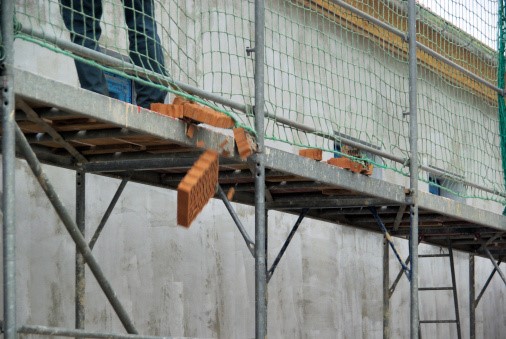
What do you think could happen if these falling bricks struck someone below’

When we think of falls, we think of workers as the ones in danger of falling from scaffolding, roofs, etc. But the tools, materials and other equipment they use can also fall from heights and endanger anyone below’including not only workers but also visitors to the site or pedestrians simply passing by it.
For example, this picture from a NY/NJ law firm shows what appear to be bricks tumbling off a scaffold. Given the likely weight of these items, one can only imagine the injuries someone might suffer if hit by one as it fell to the ground.
In fact, even lightweight, seemingly benign items can kill if they fall from a great enough height.
For example, in what can only be described as a freak accident, a 58-year-old man was recently killed in Jersey City, NJ by a one-pound tape measure after it fell about 400 feet.
The man had arrived at the large construction project to deliver wallboard. He’d parked his truck and just stepped from the vehicle when he was hit by the tape measure, which had slipped off the belt of a construction worker at the top of the tower under construction.
The man, who wasn’t wearing a hardhat at the time, was struck in the head and knocked unconscious. He was taken to the hospital, where he soon died.
Similar tragedies have happened in Canada, too.
Example: In Calgary, a couple, their son and daughter were walking down the street when wind blew a bundle of steel off the roof of a construction project, striking the group. The three-year-old daughter died instantly; the husband and son were injured. Two companies pleaded guilty to violating the Alberta Safety Codes Act by allowing an unsafe condition on the worksite and were each fined $15,000.
There are several lessons you can learn from this picture and these incidents.
Lesson #1: Take steps to ensure tools and materials don’t fall. Whenever workers are working at heights’whether on a scaffold, elevated platform, unenclosed construction site, roof or the like’take steps to prevent tools and materials from falling. For example, the wind can lift materials and tools if they aren’t properly secured. So tie down, tether or otherwise secure these items.
In addition, the OHS regulations may require you to install toe boards to prevent tools and materials from falling. For example, Sec. 321(3) of Alberta’s OHS Code 2009 requires an employer to ensure that toe boards are installed at the outer edge above the work area of temporary scaffolding or a temporary work platform if materials can fall more than 3.5 metres.
In the picture, while the fencing along the scaffold might help prevent workers from falling, the gap at the bottom made it clearly inadequate to prevent materials or tools from doing so.
And good housekeeping practices can help keep materials from posing a safety risk. For example, require workers to regularly sweep up or gather scrap materials and remove them from the work area so they can’t fall.
Lesson #2: Wearing proper head protection is important. If workers are at risk of being hit in the head, it’s critical that they wear proper head protection. For instance, if the man in NJ had been wearing a hardhat when he was struck by the falling tape measure, he might have survived the incident.
Lesson #3: The duty to ensure safety extends beyond workers. An employer’s duty to ensure a safe workplace may extend beyond its employees to contractors and their employees, visitors to the workplace and even passersby (especially at construction sites). For example, most jurisdictions have so-called occupiers’ liability laws that impose a duty on the owners or users of property to take reasonable care, under the circumstances, to see that visitors are reasonably safe on the property.
So ensure that your safety measures protect anyone who could be endangered by activities, equipment, materials, etc. at your workplace. And implement a visitor safety policy.
